
Hello! My name is Hannah and I’m (finally) a senior at TAHS. I hope to be writing the swim stories and other student and alumni spotlights. This is my...
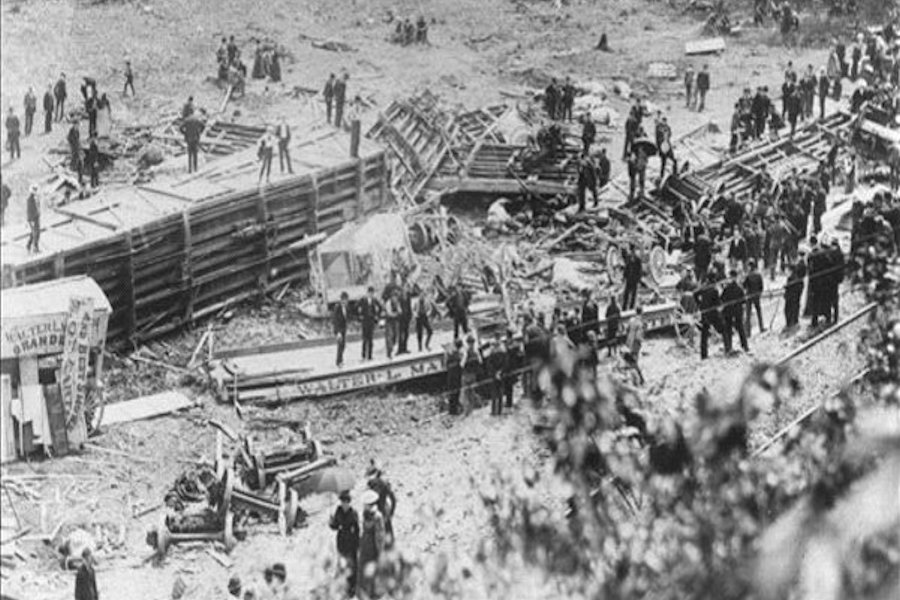

May 30, 2019
Memorial Day in 1893 was a historic day for the small town of Tyrone. Walter L. Main’s Circus was traveling on the Tyrone and Clearfield Railroad from Houtzdale to Lewistown when the train flew off of the tracks, crashing into the mountainside.
Taking the lives of six men and hundreds of animals, the community of Tyrone gathered together to clear the wreckage. Townsfolk fed, sheltered, and cared for the performers, crew, and animals.
May 30th, 1893, continues to be remembered and recognized within not only our town but within the circus community as members return each year for a memorial service.
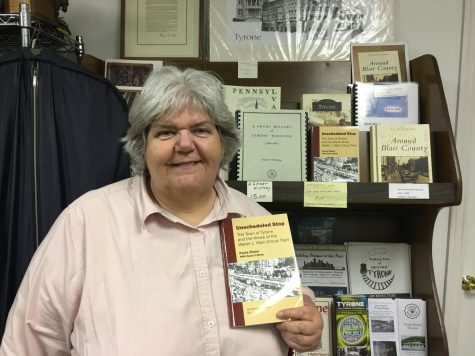
This event was so remarkable a movie scene from The Greatest Show on Earth (1952) and a book, entitled Unscheduled Stop: The Town of Tyrone and the Wreck of the Walter L. Main Circus Train, was inspired about the subject by anthropologist, public and industrial archeologist, and Penn State Altoona and Penn Highlands professor Paula Zitzler with Tyrone local Susie O’Brien.
As people emerged to help and hunt in 1893, it was also an odd sight to see such exotic animals and performers walking down the unpaved streets of the small town of Tyrone.
To transport coal from Houtzdale to Tyrone and areas beyond, the railroad tracks would have to cross the Allegheny Front and mountain region. The easiest way to lay the track was between the steepest parts of the mountain where a valley may lay. Of course, it was impossible to completely avoid all steep and challenging terrain.
However, the railroad was laid to snake around in an “S” shape and rise every three feet for every 100 feet of track, giving Pennsylvania famous railroad sites such as the Horseshoe Curve. This is similar to how Old Tyrone Pike traveling from Bald Eagle to Phillipsburg is paved as the road takes dips and turns.
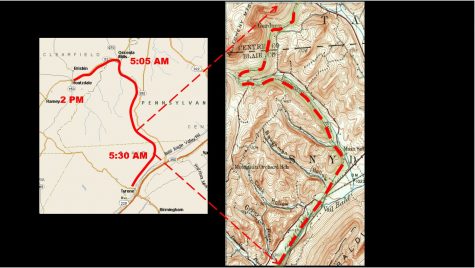
Laying the track in this strategic matter made climbing up the mountain easier for the engineers. On the other hand, going down the mountain was difficult for brakemen because the weight of cars and gravity was not always on their side.
With Tyrone’s tracks, going down the mountain into town, there was a curve, then a small straight stretch, then finally a right angle turn.
Regular train cars were typically 30 feet in length. The average train had 15 to 17 cars. The question should not have been how many cars, but the length of the cars.
On the day of the accident, Main’s train had 17 cars, the maximum number allowable. However, the length of his cars was the issue. Main’s cars were twice as long as standard rail cars, nearly 60 to 70 feet long. Along with the strange cargo of exotic animals, tents, poles, a dining car, and sleeper cars compared to lifeless coal came together to result in the circus tragedy.
The engineer breathed a sigh of relief after rounding the first “U” turn at approximately 5:20 a.m. coming into Tyrone. However, his relief was short-lived as everyone in the engine car knew what was ahead: the dreaded right angle turn, and the train only seemed to be picking up speed.
The speed limit was 12 miles per hour around the turn. However, the engineer later admitted that the train was running at double that speed at 25 to 30 miles per hour. On another account, William LaRue, a clown and acrobatic performer, wrote to his father, stating the train was traveling at a speed of 100 miles per hour.
As the brakemen tried to turn the last three hand brakes on the tops of cars, seven of first 14 cars had airbrakes, while the second half did not. As this method was clearly not working, the engineers put the engine in reverse, which is usually used as a last resort since this could, in turn, blow up the engine.
Although short-lived, the first two cars, the engine car and the tender or fuel car, passed the right angle turn. As the crew began to cheer, disaster struck, altering the course of Main’s circus gang and the community of Tyrone.
When rounding a turn going too fast, passengers or cargo are jolted or tilted in the direction of the turn, then lean again in the opposite direction. This movement was in part responsible for the accident. The elephant car was the third car from the front of the train. The weight of that loaded car along with the movement of the elephants, which was involuntary, led to a chain reaction of the cars leaving the railroad tracks.
As this third car broke off, the rest of the cars followed, running straight off instead of making the right turn. Each car trailing off resulted in a pancake effect with the cars stacking on top of each other.
Eventually, as the cars became stacked as high as the track, the dining car or combination car got turned perpendicular to the track. This was fortunate for all of the many performer passengers since the remaining train cars they were in remained safely on the track as the last cars were already beginning to slow as well.
During a trial to determine responsibility for the accident and if the train was safe in the first place, the engineers claimed the elephants moving caused the accident. The Clearfield Progress from December 14th, 1967, wrote, “There are many rumors and ideas about the cause of this wreck, but in my opinion the most plausible is that the engineer lost control of the train because he had too big a load to hold for one engine and the long cars could not round the curves at the high rate of speed attained.”
This pancake effect and perpendicular railcar helped keep the number of human casualties low, but the number of traumatized, injured, and dead animals was unfortunately greater.
Although no wreck is good, Tyrone was the perfect place to wreck.
With a main station in Tyrone, known as Vail Station, it was easy to get more train cars for the passengers and performers to sleep in. Altoona was the railroad headquarters of the Pennsylvania Railroad at the time. This meant that they had the proper equipment to rebuild Main’s damaged cars and build new cars to replace the wrecked ones. The Altoona headquarters could build them to regulation widths and fit them for standard railroad qualifications.
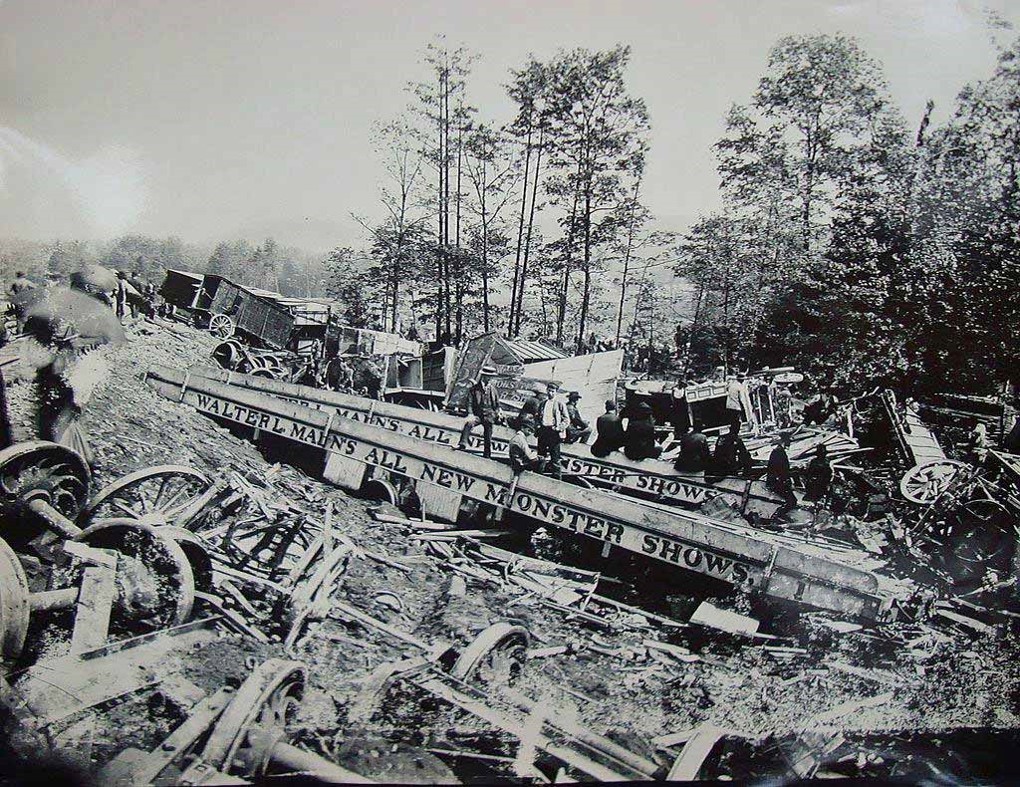
The rail cars became stacked on top of one another in a pancake effect
From the first moments after the wreck, it was clear that this was no ordinary derailment.
Initially, an engineer and a fireman left the scene to get help but were surrounded by hyenas after a short walk down the tracks.
As animals escaped from their cages and word spread of the crash, townsfolk flocked to the scene to aid the injured, capture circus creatures, and see the commotion unfold.
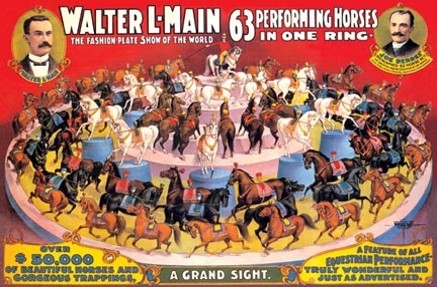
As written in Zitzler’s book, “The fear of encountering a wild animal did not discourage sightseers from continuing to visit the wreck. … the road was crowded with wagons, horses, and pedestrians. Others streamed down the mountain from Philipsburg, eager to get a look at the destruction. The Republican, a Clearfield County newspaper, reported that many returned “loaded with relics” .”
Main’s circus was known for its horses. Showhorses, ponies, and colts were the stars of the show as horse trainers rode them around the big top. Equestrian acts, chariot races, and daring acts, such as standing on two horses while juggling torches and knives, jumping back and forth, hurdling hoops sometimes on fire at rampaging speeds, and much more, were the sight-stealing foundation for the circus.
Three newspaper accounts testify, “Blood was tracked for three miles all along the tracks and road where horses had walked, bleeding… In one place, not 20 feet square, lay the bodies of eight horses, a little pony, and its young foal. In another were five horses, and close by was a crushed boxcar with an inextricable mass of horses, harness, and timber, impossible to picture. All were dead…I recall seeing the dead horses, mostly white.”
Hundreds of horses and ponies were killed. It is suspected that a mass grave was dug near the area to dispose of the dead cargo.
The only town doctor hitched a ride into Tyrone on a wagon. However, traffic was so heavy and congested as people drove to the site that the doctor decided to walk the rest of the way. Jumping out of the wagon, he immediately witnessed two men wrestling a large, black snake in a ditch.
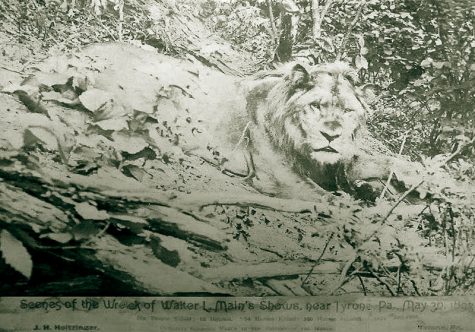
Other interesting stories have arisen from the incident like local cows and chickens being eaten.
The circus had two lions. One was laying under a tree and was easier to catch. Two men were able to put a rope around its neck and tie it to the nearby tree. The other lion was fighting with two tigers and had to be shot as it could not be contained.
Only one elephant was traumatized and underwent a personality change. No other elephants died.
The gorilla named “Man Slayer” sat on a stump and growled at anyone who got near him. Eventually, two men came from both sides, successfully slipped two ropes over his head, and secured him to a tree as a cage was prepared.
Reptiles slithered into the forest. Parrots, along with other colorful birds, and monkeys joined the squirrels and chipmunks in the trees. The two alligators laid nearby under the shade of tree. Pigs, zebras, cheetahs, camels, tigers, an ox, water buffalo, bears, and panthers among countless other creatures were onboard the train and found in shock, angry, escaped, or dead.
Whatever animals escaped into the Pennsylvania wilderness could not have lived long as the impending winter would return in almost six months, where the freezing temperatures would be unlivable for the exotic animals.
Not only do the circus animals reveal an interesting story, the people do as well.
Acrobats, horse trainers, equestrians, trapezists, clowns, magicians, musicians, dwarfs, giants, bicyclists, long-haired men and women, glassblowers, managers, laborers, canvasmen and more human oddities, talents, and help united to form what was the Main circus crew.
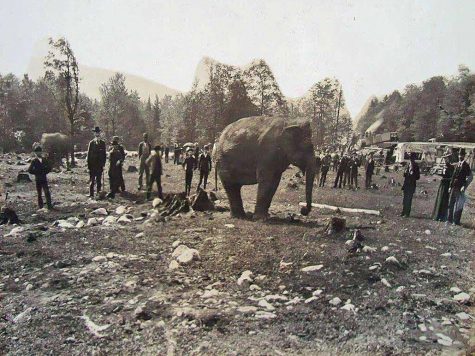
“The wreck claimed the lives of six men. Another dozen were injured seriously enough to be taken to the hospital for treatment. Countless others suffered cuts and bruises. The emotional impact to survivors was undoubtedly long-lasting. The unexpected and sudden loss of fathers, sons and brothers was more than some families could stand.”
After the damage, many were found tending to horses and people. Even elephants helped by carrying heavy items and unrooted trees.
As Zitzler wrote, “Those passengers that were unhurt came quickly to the aid of the injured, or tried to. The animals of the menagerie, now freed from their cages and shackles, many for the first time ever, relied on their wild instincts for survival. Shocked, injured and traumatized, the big cats intimidated the troupe and the other animals.”
After the wreckage was cleared in three days, Main and his crew replaced animals, equipment, and railcars rapidly. Performers and musicians began practicing in the streets of Tyrone to stay in shape and keep their skills sharp.
Stables were opened to house the horses. Hotels opened their doors for guests. At the Tyrone station, performers slept in sleeper railcars.
Many Tyrone residents were sympathetic to the grief felt by the circus performers, but couldn’t help contain their excitement since it had been over two years since a big top had rolled into town. Main decided to show to his gratitude to Tyrone by performing a free show a little over a week after the total chaos and destruction that occurred.
Although the majority of townsfolk supported the circus crew, others were wary. In 1893, immigrants were often unwelcomed. As a wave of foreign people strolled into Tyrone, people began feeling nervous and suspicious.
The circus gang is typically full of odd, strange, and “freaky” people. Add in the foreign aspect and the trauma these people were in created high tensions and an uneasiness among some locals.
There were no accounts of violence or discrimination toward the circus members. However, Main was surprised when he was charged $400 by a businessman for the use of his office.
In nine days, the Walter L. Main Circus was back on schedule and on the tracks to Harrisburg. Main was charged and fined on arrival for cruelty to animals as some were still traumatized. Due to lack of communication and records, it was difficult to charge Main as the circus moved around frequently and not all authorities knew of his actions.
The six human bodies were given proper burials. Tyrone mourned and celebrated the lives of these men who they had never met.
“In small towns, weddings and funerals are often community events. Family connections run deep, as do friendships. When a family is diminished by death or expanded by marriage, the community of friends and neighbors joins in the mourning or the celebration. In the days following the wreck, the people of Tyrone came together to mark the passing of six men, including three that they never met in life.”
Treasurer Frank Train was in the money car, the fourth car, behind the elephants. His body was taken to the state of Indiana where both of his parents resided.
Two men, Multaney and Lee, are buried here in Tyrone at Grandview Cemetery.
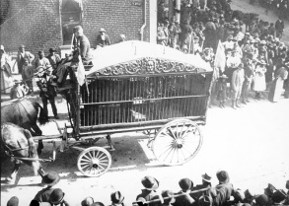
Over the course of the week, Main replaced his show horses and train cars. Locals and other circuses companies and competitors offered to chip in as well.
The wreck occurred on a Tuesday, and the next Thursday, June 8th, Main hosted a circus performance to thank Tyrone for its hospitality and express their appreciation. Posters were plastered that Friday and Saturday, announcing the news.
Other small events took place around town too. A small recital at the Saint Matthew’s Academy of Music on Friday night was accompanied by the circus’s orchestra. The professional musicians sight read alongside the young players to draw a larger audience for the evening. Sixteen little boys performed a flag drill that night too. More than $300 was raised for the local school.
Spontaneous concerts were held on street corners when the circus band needed to practice. They even provided music for the baseball game when Tyrone played State College on Saturday afternoon.
Other circus members learned to work with their new instruments, equipment, and animals as many needed to be replaced or retrained after their shocked and panicked state.
On the circus’ last day in Tyrone, people watched in amazement as the circus paraded down the street toward the big top near the Saint Matthews church. Acrobatic acts, singers, trapeze stunters, and bareback riders were welcomed by the wide-eyed audience of Tyroneians. The crowd watched as the circus packed up at 3 a.m. and hit the rails for Lewistown.

This memorial on Vascoyoc Hollow Road was ereceted in 1975
Over the years, many stories, rumors, conspiracies and passed-by-ear tales have made their way into modern times.
Notoriously, the skull of a tiger hangs at the local Tyrone Sportsman’s Club that chased Hiram Friday’s daughter, Hannah, from their barn as she was milking a cow to their house.
There were sightings of various animals around Pennsylvania at the time: three kangaroos in Warriors Mark, panthers chasing chickens in town, parrots in the trees, “yellow dogs”, possibly hyenas, attacking in Huntingdon, a large, black snake in Scranton, and others that may not have been reported.
Since these animals lived around trains and railroads their whole life, it is possible that they hopped on trains or followed the tracks, resulting in why the circus creatures were found far away from Tyrone.
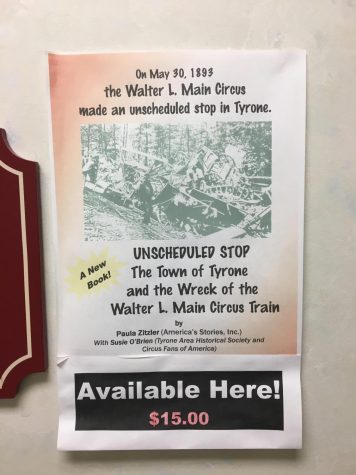
Apparently, for conspiracists, the Tyrone trainwreck is used as reasoning for some creatural phenomenons. Bigfoot, jackalopes, and other such krypto creatures are believed to have been interbred from the exotic circus animals and the indigenous Pennsylvania animals.
Still relevant today, every year a special remembrance service is held along Vanscoyoc Road at the site of the memorial in late May.
Today, circuses are downsizing with a greater focus on human talents rather than animal tricks. A reoccurring accident such as this is highly unlikely.
Zitzler writes in her book, “More than a century later, the people of the town take pride in their town and their ancestors who offered aid and encouragement to the stranded circus during its unscheduled stop. The annual memorial service is a community event, no longer the responsibility of whatever circus troupe happened to be traveling through… The response of the people of Tyrone to the wreck of the Walter L. Main Circus train has become a signature event in the history of Tyrone, setting a standard for community hospitality that is still respected.”
In the scheme of life and worldly events, the Tyrone circus train wreck is small, but for Tyrone’s community and the circus community, it was a significant moment in our history that will forever be remembered and mourned.

Hello! My name is Hannah and I’m (finally) a senior at TAHS. I hope to be writing the swim stories and other student and alumni spotlights. This is my...
Dr Karl Bodtorf • Feb 15, 2024 at 9:01 pm
The figure on the far left is Rev Roy Bodtorf, my father. He presided over this ceremony. I have a nearly identical picture (different angle…actually a much clearer image). I ran across the photograph when clearing out the family home after both parents had passed. At the time I no idea what-so-ever as to what was taking place in the picture. It was such an unusual image. I eventually discovered the story.
Becky Davidson • May 4, 2020 at 8:07 pm
I can remember my grandmother telling me about this. I grew up in the Warriors Mark Tyrone area. It’s an interesting part of the history. Thank you for sharing it.
Jessica • May 30, 2019 at 5:11 pm
Hiram Friday’s daughter was killed by the tiger, and a lot of the animals were found or captured up on the old Friday Farm! It’s a great story about the train wreck!
Mary Edna Lykens • Jun 14, 2024 at 10:17 am
Hiram Friday’s daughter was not killed but the cow she was milking was killed. A neighbor then shot the tiger and it’s skull is on display at the Tyrone Sportsmen’s Club.
Brandon Sprankle • May 30, 2019 at 2:42 pm
Good job on this you got a lot right but fun fact, as one of the people who live on the road of the memorial site and crash site we have some of the circus animals buried in our yards. We had them scanned so this is no mere rumor.
Brandon Sprankle • May 30, 2019 at 2:42 pm
Good job on this you got a lot right but fun fact, as one of the people who live on the road of the memorial site and crash site we have some of the circus animals buried in our yards. We had them scanned so this is no mere rumor. I have a horse buried underneath my yard. We made a little memorial for the horse in our back yard for the poor horse.